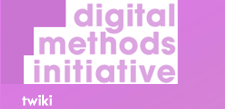You are here: Foswiki>Dmi Web>WinterSchool2025FormatsOfIdeology (13 Feb 2025, BernRieder)Edit Attach
Formats of ideology: Investigating video genres across issue spaces
Team Members
Bernhard Rieder, Dominik Vrabič Dežman, Sammy Chen, Düet Turgay, Vasilisa Kuznetsova, Joe Llewellyn, Haozhou Lu, Anna Ostraya, Chayenne Hess, Shuyi Chen, Minsoo Lee, Xiangnan Yu, Zhiying Li, Hanqiong Ding, Jinzhuo Li1. Introduction
Although scholars have been attentive to the many kinds of audiovisual experimentation on YouTube and the emergence of "prototypical user-created video forms" (Burgess and Green 2018), there has been little systematic investigation of these forms and formats, and how they intersect with specific themes and communicative objectives. At the same time, there has been a clear awareness that YouTubers positioning themselves as alternatives to the “mainstream media” not only not only position themselves in ideological terms, but in terms of content dramaturgy, which “bears little resemblance to traditional news formats, instead often representing genres native to YouTube, such as vlogging, livestreamed debates, and “response” videos” (Lewis 2020). The argument, here, often holds that these genres lend themselves particularly well to establishing trust, authenticity, and parasociality, making them highly influential. Few studies, however, have attempted to approach genres and formats more substantially, for example, by categorizing them into specific “television formats and web formats” (García-Avilés and de Lara 2024). At the same time, the rise of TikTok and the subsequent introduction of Instagram Reels and YouTube Shorts have again cast the spotlight on video formats, this time in close relationship with the question of platform affordances and their effects on video creation, distribution, and consumption. A growing number of studies (e.g., Duan et al. 2024, Rajendran et al. 2024) have begun to compare and contextualize short-form video across platforms and within the YouTube ecosystem. Coming from the other end of an imaginary “length spectrum” and less visible than the rise of short-form video, the increasing success of podcasts (which often provide a video version on YouTube) and long-form interviews has added fuel to the question how audiovisual formats connect with topic spaces and audiences. Our project aims to investigate the “format question” through a number of case studies that focus on explicitly “political” topics as well as more “leisurely” themes with clear ideological connotations, to better understand how these issue spaces are constituted through specific video genres and formats. This includes paying attention to the creators producing these contents as well as reactions coming from audiences.2. Overall Research Questions
While this project followed, at least in part, an exploratory logic these were our main starting points:- How are different topic spheres constructed through specific sets of video forms and formats? How can we categorize them and investigate the roles they play in these issue spaces?
- What kinds of actors are producing these contents, and can we relate specific types of actors to specific forms and formats?
- Can we map differences in audience reactions (both quantitative and qualitative) across formats? How to interpret these differences?
- Can we automatically detect (and even analyze) video formats with the help of LLMs/LVMs and other (AI) techniques?
3. Subprojects
References
- Burgess, Jean, and Joshua Green. 2018. Youtube: Online Video and Participatory Culture. Second edition. Digital Media and Society. Cambridge, UK ; Medford, MA: Polity Press.
- Duan, Yiran, Christy Khoury, Una Joh, Alex O. Smith, Calvin Cousin, and Jeff Hemsley. 2024. “Comparing Climate Change Content and Comments across Instagram Reels, TikTok , and YouTube Shorts and Long Videos.” Proceedings of the Association for Information Science and Technology 61 (1): 103–14. https://doi.org/10.1002/pra2.1012.
- García-Avilés, José Alberto, and Alicia de Lara. 2018. “An Overview of Science Online Video: Designing a Classification of Formats.” In Communicating Science and Technology Through Online Video. Routledge.
- Lewis, Rebecca. 2020. “‘This Is What the News Won’t Show You’: YouTube Creators and the Reactionary Politics of Micro-Celebrity.” Television & New Media 21 (2): 201–17. https://doi.org/10.1177/1527476419879919.
- Rajendran, Prajit T., Kevin Creusy, and Vivien Garnes. 2024. “Shorts on the Rise: Assessing the Effects of YouTube Shorts on Long-Form Video Content.” arXiv. https://doi.org/10.48550/arXiv.2402.18208.
- Rieder, Bernhard, Òscar Coromina, and Ariadna Matamoros-Fernández. 2020. “Mapping YouTube.” First Monday 25 (8). https://doi.org/10.5210/fm.v25i8.10667.
- Violot, Caroline, Tuğrulcan Elmas, Igor Bilogrevic, and Mathias Humbert. 2024. “Shorts vs. Regular Videos on YouTube: A Comparative Analysis of User Engagement and Content Creation Trends.” In ACM Web Science Conference, 213–23. Stuttgart Germany: ACM. https://doi.org/10.1145/3614419.3644023.
| I | Attachment | Action | Size | Date | Who | Comment |
|---|---|---|---|---|---|---|
| |
WS2025_FoI_ClimateChane.pdf | manage | 898 K | 13 Feb 2025 - 12:46 | BernRieder | |
| |
WS2025_FoI_LuigiMangione.pdf | manage | 1 MB | 13 Feb 2025 - 12:47 | BernRieder | |
| |
WS2025_FoI_UkraineWar.pdf | manage | 905 K | 13 Feb 2025 - 12:47 | BernRieder |
Edit | Attach | Print version | History: r1 | Backlinks | View wiki text | Edit wiki text | More topic actions
Topic revision: r1 - 13 Feb 2025, BernRieder
 Copyright © by the contributing authors. All material on this collaboration platform is the property of the contributing authors.
Copyright © by the contributing authors. All material on this collaboration platform is the property of the contributing authors. Ideas, requests, problems regarding Foswiki? Send feedback


